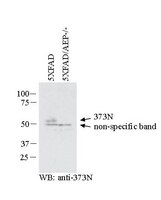ABN1643 Sigma-AldrichAnti-APP Antibody, AEP-cleaved (373N)
Anti-APP, AEP-cleaved (373N), Cat. No. ABN1643, is a highly specific rabbit polyclonal antibody that targets the N-terminal fragment of AEP-cleaved APP at residue 373 (373N) and has been tested in Immunohistochemistry and Western Blotting.
More>> Anti-APP, AEP-cleaved (373N), Cat. No. ABN1643, is a highly specific rabbit polyclonal antibody that targets the N-terminal fragment of AEP-cleaved APP at residue 373 (373N) and has been tested in Immunohistochemistry and Western Blotting. Less<<Recommended Products
Overview
| Replacement Information |
|---|
Key Spec Table
| Species Reactivity | Key Applications | Host | Format | Antibody Type |
|---|---|---|---|---|
| M, H | IHC, WB | Rb | Serum | Polyclonal Antibody |
| References |
|---|
| Product Information | |
|---|---|
| Format | Serum |
| Presentation | Rabbit polyclonal antibody serum with 0.05% sodium azide. |
| Quality Level | MQ100 |
| Physicochemical Information |
|---|
| Dimensions |
|---|
| Materials Information |
|---|
| Toxicological Information |
|---|
| Safety Information according to GHS |
|---|
| Safety Information |
|---|
| Packaging Information | |
|---|---|
| Material Size | 100 µL |
| Transport Information |
|---|
| Supplemental Information |
|---|
| Specifications |
|---|
| Global Trade Item Number | |
|---|---|
| Catalogue Number | GTIN |
| ABN1643 | 04054839092152 |
Documentation
Anti-APP Antibody, AEP-cleaved (373N) SDS
| Title |
|---|
Anti-APP Antibody, AEP-cleaved (373N) Certificates of Analysis
| Title | Lot Number |
|---|---|
| Anti-APP, AEP-cleaved (373N) - 4107254 | 4107254 |
| Anti-APP, AEP-cleaved (373N) -Q2774379 | Q2774379 |









